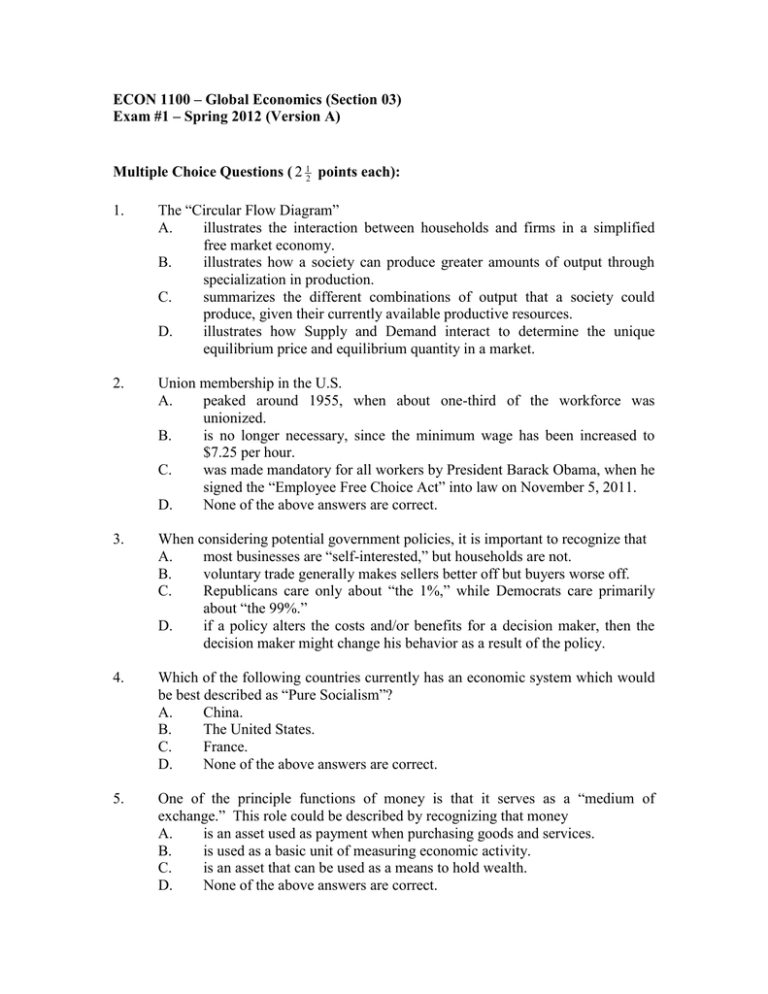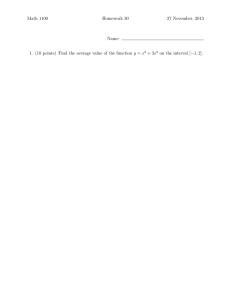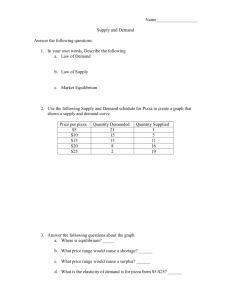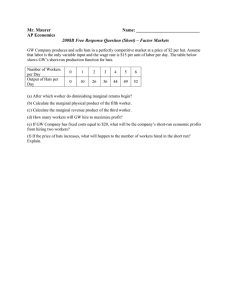ECON 1100 – Global Economics (Section 03) Multiple Choice Questions (
advertisement

ECON 1100 – Global Economics (Section 03) Exam #1 – Spring 2012 (Version A) Multiple Choice Questions ( 2 12 points each): 1. The “Circular Flow Diagram” A. illustrates the interaction between households and firms in a simplified free market economy. B. illustrates how a society can produce greater amounts of output through specialization in production. C. summarizes the different combinations of output that a society could produce, given their currently available productive resources. D. illustrates how Supply and Demand interact to determine the unique equilibrium price and equilibrium quantity in a market. 2. Union membership in the U.S. A. peaked around 1955, when about one-third of the workforce was unionized. B. is no longer necessary, since the minimum wage has been increased to $7.25 per hour. C. was made mandatory for all workers by President Barack Obama, when he signed the “Employee Free Choice Act” into law on November 5, 2011. D. None of the above answers are correct. 3. When considering potential government policies, it is important to recognize that A. most businesses are “self-interested,” but households are not. B. voluntary trade generally makes sellers better off but buyers worse off. C. Republicans care only about “the 1%,” while Democrats care primarily about “the 99%.” D. if a policy alters the costs and/or benefits for a decision maker, then the decision maker might change his behavior as a result of the policy. 4. Which of the following countries currently has an economic system which would be best described as “Pure Socialism”? A. China. B. The United States. C. France. D. None of the above answers are correct. 5. One of the principle functions of money is that it serves as a “medium of exchange.” This role could be described by recognizing that money A. is an asset used as payment when purchasing goods and services. B. is used as a basic unit of measuring economic activity. C. is an asset that can be used as a means to hold wealth. D. None of the above answers are correct. 6. With which of the following statements is there “general agreement” among most economists? A. “A minimum wage reduces unemployment among young and unskilled workers.” B. “Fiscal Policy can never have any stimulative impact on macroeconomic performance.” C. “A wealthy society has an obligation to provide free medical services to all citizens (even those people with very low incomes).” D. “Cash payments increase the welfare of recipients to a greater degree than do transfers-in-kind of equal cash value.” 7. Consider a society consisting of only three people: Bea, Arthur, and Maude. Bea and Arthur spend all day producing clothing and food. At the end of each day they bring their output to Maude, who divides it between the three individuals. The “basic economic question” that Maude is answering for this society is the A. Distributional Decision. B. Production Decision. C. Choice of Economic System. D. Choice of Technique. For Questions 8 though 10, consider a society consisting of only two workers, Jen and Ben, who spend their workdays producing either soup or hats. The productive ability of each worker for each task is summarized in the table below (which states the number of units of each good that the worker could produce in a full day): Ben Jen Soup 90 bowls per day 40 bowls per day Hats 30 hats per day 20 hats per day 8. _____ has an Absolute Advantage in the production of Soup; _____ has an Absolute Advantage in the production of Hats. A. Ben; Jen. B. Jen; Ben. C. Ben; Ben. D. Jen; Jen. 9. Based upon the given information, Jen’s Opportunity Cost for producing a hat is A. 20 hats. B. $20. C. 2 bowls of soup. D. half a bowl of soup. 10. Jen has a Comparative Advantage in A. the production of neither soup nor hats. B. the production of both soup and hats. C. the production of soup (but not in the production of hats). D. the production of hats (but not in the production of soup). 11. The “Principal/Agent Problem” refers to A. one of the three principle functions of money. B. problems that arise because of difficulties associated with getting agents (e.g., workers) to take actions that are best for principals (e.g., firms). C. the recognition that a rational individual will take an action if and only if the additional benefit of the action is greater than its additional cost. D. inefficiencies which result from “too much trade” taking place in a market. 12. “The United Way” is a good example of A. a Non-Governmental Organization. B. a Government Agency. C. an Enterprise. D. a Labor Organization. 13. Which of the following statements is a “Positive Statement”? A. The United States would be a better country if the Federal Government were the sole provider of all medical services. B. Hockey legend Wayne Gretzky scored a total of 894 goals during his professional career in the NHL. C. The funniest movie of 2011 was “Hall Pass.” D. More than one (perhaps all) of the above answers is correct. 14. ___________ traces its philosophical roots to the work of 19th Century Philosopher Karl Marx. A. Capitalism B. Communism C. Consumer Sovereignty D. The “Invisible Hand” 15. Armen Alchain and Gordon Tullock A. argued that automobile accident rates could be decreased by installing a sharp, irremovable, foot long, iron spike to the steering wheel of every car. B. wrote a letter to FDR in 1939, advising him to have the U.S. government assist physicists in the U.S. working on research related to the creation of a uranium bomb. C. were the first to recognize that eliminating the minimum wage would decrease the unemployment rate of young and unskilled workers. D. None of the above answers are correct. 16. A recent article in The Economist stated: “____________ – a commercial venture that protects its shareholders from personal bankruptcy – is one of the greatest wealth-creating inventions of all time.” A. Limited Liability B. The Principle of Comparative Advantage C. Indicative Planning D. Crony Capitalism 17. In which of the following countries do individuals enjoy the greatest amount of Economic Freedom? A. Russia. B. Brazil. C. India. D. Singapore. 18. Kevin is concerned that his ten year old son is not performing up to his full potential in school. In order to give him an additional reason to bring up his grades, he offers to pay his son $25 for every “A” that he gets on his next report card. Kevin is trying to alter his son’s behavior by way of A. Command Planning. B. coercion. C. a material incentive. D. moral persuasion. 19. Adam Smith was A. a 17th century French philosopher. B. an 18th century Scottish economist. C. a 19th century German philosopher, economist, and revolutionary. D. a 20th century American economist. For Questions 20 through 22, consider the following information regarding Mary’s Total Benefits from consumption of pizza in January (measured in dollars): Pizzas Consumed: 0 Total Benefits from Consumption: 0 1 24 2 44 3 60 4 72 5 80 6 86 20. Suppose Mary paid a total of $50 in order to consume 3 pizzas. It follows that A. her Economic Surplus would be equal to $10. B. her Economic Surplus would be equal to $60. C. her Economic Surplus would be equal to $110. D. her Economic Surplus would be negative. 21. Mary’s “Marginal Benefit” for her 5th pizza consumed would be A. $80. B. $16. C. $8. D. None of the above answers are correct (since it is impossible to determine the value of “Marginal Benefit” at any level of consumption from the given information). 22. If the price of pizza were to increase from $11 to $14, Mary A. would stop buying pizza altogether. B. would decrease her consumption of pizza (but still buy some pizza). C. would not alter her consumption of pizza. D. would increase her consumption of pizza. 23. Which of the following is a basic characteristic of Capitalism? A. Income is distributed on the basis of “need.” B. Economic decisions occur in markets. C. Factors of production are owned by the government. D. More than one (perhaps all) of the above answers is correct. 24. Which of the following is one of the “Three Basic Economic Questions” that every society must address? A. “Which resources should be used for the production of which goods/services?” B. “How can we reduce our carbon footprint?” C. “How can we make sure that every single person in society gets a college education?” D. More than one (perhaps all) of the above is one of the “Three Basic Economic Questions” that every society must address. 25. Zack and A.C. produce surfboards and oranges. Zack possesses an Absolute Advantage in the production of both surfboards and oranges. Further, Zack’s opportunity cost of producing a surfboard is higher than A.C.’s opportunity cost of producing a surfboard. The Principle of Comparative Advantage suggests that they can increase their total output of these two goods if A. Zack focuses his production on oranges while A.C. focuses his production on surfboards. B. Zack focuses his production on surfboards while A.C. focuses his production on oranges. C. A.C. produces all of the oranges and all of the surfboards for the society, while Zack produces neither of the two goods. D. Zack produces all of the oranges and all of the surfboards for the society, while A.C. produces neither of the two goods. 26. Andrea has $80 to spend and wants to purchase either a new amplifier for her guitar or a new MP3 player. Each good costs exactly $80, so she can only purchase one of the two items. This scenario illustrates the basic concept that A. people face tradeoffs. B. most consumers are irrational. C. free market systems generally do a very poor job of allocating consumption goods. D. people respond to incentives. 27. Which markets are represented in the simple “Circular Flow Diagram”? A. Markets for “Goods and Services” and markets for “Factors of Production.” B. Markets for “Financial Assets” and markets for “Imports and Exports.” C. Markets for “Imports and Exports” and markets for “Factors of Production.” D. None of the above answers are correct. 28. The primary objective of most private enterprises in a free market system is to A. exploit workers. B. produce low cost, low quality goods. C. earn as large of a profit as possible. D. strive for social justice. 29. In 2009 High School graduates earned $14,500 per year more than non-High School graduates. If this difference had instead been $18,000 per year, then we would expect A. more people to drop out of school before graduating High School. B. fewer people to drop out of school before graduating High School. C. more parents to encourage their children to find employment outside of the home at the end of the school day. D. that nobody would change their behavior. 30. ________________ refers to the freedom of an individual to buy or not buy a good/service at a price determined in an unfettered market. A. The Invisible Hand B. The Cost-Benefit Principle C. Command Planning D. Consumer Sovereignty 31. Which of the following is an example of a “Produced Asset”? A. The “college education” which has been acquired by approximately 27% of the U.S. population. B. New York Harbor, at the mouth of the Hudson River in New York, NY. C. The Vogtle Nuclear Electric Generating Plant near Augusta, GA. D. None of the above answers are correct. 32. Under “Indicative Planning” A. the government relies upon the voluntary response of the private sector to a set of guidelines jointly formulated by government, industry, and labor. B. the government directly controls all economic activity, and nearly all production takes place in government owned enterprises. C. all people are ultimately given equal amounts of income and consumption. D. None of the above answers are correct. 33. One of the three types of “Economic Incentives” is “Moral Persuasion,” which could be described as A. the use of “force” or “intimidation” to obtain compliance. B. attempts to convince individuals to behave in a certain manner because it is “the right thing to do.” C. the use of “monetary rewards” or “direct increases in consumption” which result from engaging in an activity. D. None of the above answers are correct. 34. Scott and Brad fix computers and bicycles. If Scott possesses both an Absolute Advantage and a Comparative Advantage at fixing computers, then Brad A. must possess a Comparative Advantage at fixing bicycles. B. must possess an Absolute Advantage at fixing bicycles. C. Neither (A) nor (B) are necessarily correct. D. Both (A) and (B) must be correct. 35. Normative Statements A. involve “value judgments” and attempt to make comparisons of the relative desirability of different options based upon these values. B. attempt to describe “how the world should be” or “how the world could be improved upon.” C. are the only types of statements which economists ever make. D. More than one (perhaps all) of the above answers is correct. For Questions 36 and 37, consider a society facing the Production Possibilities Curve illustrated below: Guns 1,350 1,000 A 800 B 500 D 375 C Butter 0 0 300 420 600 36. Which of the following combinations of output is “unattainable”? A. “A” (600 units of butter and 1,000 guns). B. “B” (420 units of butter and 800 guns). C. “C” (300 units of butter and 375 guns). D. More than one (perhaps all) of the above answers is correct. 37. If this society wanted to produce 500 units of butter, then their maximum output of guns would be A. exactly 1,350 guns. B. exactly 800 guns. C. more than 500 but fewer than 800 guns. D. exactly 500 guns. 38. The “Index of Economic Competitiveness” attempts to measure A. the relative ease with which “the 1%” can exploit “the 99%.” B. the degree to which economic outcomes in a society are dictated by “big business.” C. the capacity of the national economy to achieve growth over the medium term, controlling for the current level of development. D. the degree to which decision makers in an economy experience a “real system” that differs from the “nominally defined system.” 39. Bankruptcy Law A. establishes the rights for a worker to seek employment in the occupation and location of his choosing. B. defines the rights and responsibilities of owners of an enterprise that becomes insolvent. C. establishes requirements for firms to publicly report their financial status using a standard system of accounting. D. specifies the actions that must be taken by different parties under differing external circumstances, and provides for enforcement or compensation in instances of non-performance. 40. Cameron states that, “For an Atlanta Hawks game, courtside tickets resell for as much as $400 per seat. At such a high price, no rational person would ever buy these tickets.” The primary problem with this statement is that it: A. fails to account for the fact that the Atlanta Hawks are the only professional basketball team in town, and consumers would therefore be willing to pay any price to attend a game. B. only focuses on one particular cost and ignores the benefits of attending a Hawks game. C. implicitly assumes that people behave rationally when making consumption decisions, which is clearly not true. D. None of the above answers are correct, since there is no flaw in Cameron’s logic. (Blank Page)





